2. 中国地质大学(北京) 海洋学院, 北京 100083
2. School of Marine Science, China University of Geoscience (Beijing), Beijing 100083, China
地层有机碳含量是单位质量岩石中有机碳元素的质量,可表明烃源岩中有机丰度,是评价烃源岩生烃潜力的重要参数(吴景富等,2013;姜在兴等,2014),因此确定地层有机碳含量有利于提高对储层产能和地下油气的评价,减小预测储层油气产能的不确定性(Pemper et al., 2009).虽然岩心分析可提供高精度的地层有机碳含量结果,但具有取心成本高、样品有限、分析费用高、耗费时间长等不足,且不能连续表征有机碳含量(朱光有等,2003;霍秋立等,2011).根据有机质在测井曲线上的响应特性,利用测井资料可建立有机碳含量与测井响应值的定量关系,获得沿井轴剖面上连续分布的有机碳含量信息(张晋言,2012;饶松等,2013).
根据有机碳含量测井评价技术研究进展,本文将其分为三种主要发展阶段:单一测井间接评价方法、不同测井结合间接评价方法及地球化学测井直接评价方法.文中介绍不同测井评价有机碳含量的方法原理,并阐述其应用过程中的优势和不足,最后对不同评价方法进行了总结和讨论.
1 岩石物理体积模型在沉积过程中,有机质与岩石骨架一起沉积,而不是填充在岩石孔隙中.随着干酪根成熟度及延展性增加,有机质可能会挤入孔隙中,但除非在含量非常高的情况下,有机质不会明显影响孔隙体积.因此,根据Nixon等人和Mendelzon等人提出的富有机质地层岩石物理体积模型(Nixon,1973; Mendelzon and Toksoz, 1985),非烃源岩是由岩石骨架和饱含水孔隙两部分组成;未成熟烃源岩是由岩石骨架、有机质及饱含水的孔隙组成;成熟的烃源岩是由岩石骨架、有机质及饱含烃类和水的孔隙组成,有机碳含量测井评价的岩石物理体积模型示意图如图 1所示.
 | 图 1 有机碳含量测井评价岩石物理体积模型示意图 Fig. 1 Petrophysical volume models in well logging evaluation of TOC |
根据富有机质地层中的测井响应特征,可建立测井值与有机碳含量的经验关系,常用的测井评价方法有自然伽马测井、自然伽马能谱测井、密度测井及碳氧比测井.
2.1 自然伽马测井由于有机质可吸附放射性物质,富有机质地层常常具有高放射性强度(庞巨丰,2005).Beers早在1945年就利用自然伽马放射性强度评价有机碳含量(Beers,1945);Schmoker建立Appalachians地区泥盆纪页岩中自然伽马放射性强度与有机质丰度的关系(Schmoker,1981).我国学者谭廷栋在上世纪八十年就开展利用自然伽马测井评价有机碳含量方法的研究,详细分析了油岩测井响应特征,并建立生油岩地层中有机质与自然伽马测井值经验关系(谭廷栋,1988).
利用自然伽马测井评价有机碳含量的优势为几乎在每口井中都测量自然伽马曲线,可在任何井眼环境中测量,且测井结果易于环境校正.不足之处在于:
(1)自然伽马放射性强度响应于铀含量,而不是干酪根.
(2)一般假设高放射性强度对应高有机碳含量,但是一些富有机质地层具有中到低的放射性强度,如中生界和新生界的湖相沉积环境的页岩.
(3)建立的有机碳含量与放射性强度的经验关系需要岩心资料刻度,且关系一般不是线性,在同一层段经验关系可能变化很大.
(4)粘土含量及其他放射性矿物会影响自然伽马放射性强度,导致有机碳含量确定精度降低.
2.2 自然伽马能谱测井地层中自然伽马放射性强度控制因素为沉积作用时水中铀含量、沉积有机质类型、沉积界面上水的化学性质以及沉积速率,因此Swanson认为地层高放射性强度归结于沉积物中铀含量(Swanson, 1960,1961).Fertl等人在西弗吉尼亚州泥盆纪Devonian黑色页岩中建立铀含量与有机碳含量的关系,如图 2所示(Fertl and Chilingar, 1988);Gonfalini应用自然伽马能谱测井在意大利Streppenosa盆地评价碳酸盐烃源岩的有机碳含量,并应用测井和岩心分析资料建立不同地质环境中的经验关系(Gonfalini,1991).我国学者也在不同地区开展利用自然伽马能谱测井评价有机碳含量的研究,陈中红等人对东营凹陷牛38井的自然伽马能谱测井的初步实验研究得出,铀含量及钍铀比值与有机碳含量存在良好的相关性(陈中红等,2004);陆巧焕等人根据岩心分析数据建立有机碳含量与铀含量的关系,并在胜利油田滋2等井中得到良好应用(陆巧焕等, 2006a,2006b);李延钧等人利用自然伽马能谱测井资料在海相页岩地层建立有机碳含量与铀含量的相关关系,并用实例证明计算值和测量值符合程度较好(李延钧等,2013).
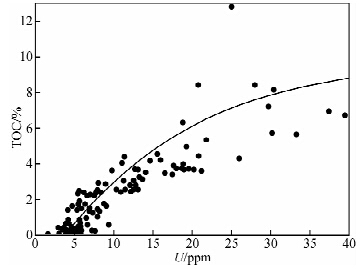 |
图 2 Devonian黑色页岩铀含量与TOC关系 (数据源于Fertl and Chilingar, 1988) Fig. 2 Relationship of uranium content and TOC in Devonian balck shale (data from Fertl and Chilingar, 1988) |
利用自然伽马能谱测井评价有机碳含量能直接利用铀含量建立与有机碳含量的关系,计算结果精度要高于利用自然伽马测井.但是,该评价方法仍受沉积速率的影响,而且地层中存在其他含铀矿物(如磷酸盐)时,与有机质无关的含铀矿物会影响计算结果.
2.3 密度测井由于干酪根的密度比较低(一般为1.1~1.4 g/cm3),富有机质地层密度相比常规储层要偏低(Tissot and Welte, 1978),因此Schmoker认为富有机质储层密度变化是由于低密度的有机质存在引起的,并提出可以利用密度测井资料估算有机碳含量(Schmoker,1980).Schmoker和Hester在Bakken等地区利用岩心分析数据建立地层密度值与有机碳含量的关系,如图 3所示(Schmoker and Hester, 1983).我国学者施生华认为粘土类生油岩由岩石基质、孔隙空间、黄铁矿和有机质四部分组成,并利用江陵凹陷生油岩测井资料建立密度测井值与有机碳含量关系(施生华,1995).
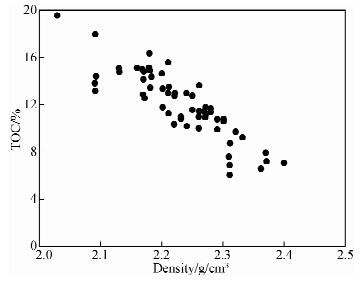 |
图 3 Bakken页岩密度与实验室测量TOC关系 (数据源于Schmoker and Hester, 1983) Fig. 3 Relationship of formation density and TOC in Bakken shale (data from Schmoker and Hester, 1983) |
基于密度测井资料的有机碳含量评价方法,其计算方法简单,密度测井曲线比较容易得到,且不需要很多环境因素校正,为地层有机碳含量评价提供了一种简单有效的方法.但是,这种算法是假设干酪根变化引起地层密度变化,由于孔隙度流体密度与干酪根密度相近,所以孔隙流体可能被误认为是干酪根,导致有机碳含量计算结果偏高,且密度测井受黄铁矿等重矿物的影响严重(Witkowsky et al., 2012).
2.4 碳氧比测井
由于碳氧比测井可获得地层碳原子与氧原子比值信息,Herron提出利用碳氧比值确定地层有机碳含量的方法(Herron,1987).在该方法中,认为地层是由岩石骨架和孔隙两部分组成,且孔隙饱含水.利用碳氧比测井中获得的碳氧比值,经环境校正后乘以地层中氧原子得到地层碳元素信息,并扣除碳酸盐岩矿物中的无机碳而获得有机碳含量.
骨架和流体中氧元素含量Osol和Ofl分别为

地层中氧元素含量为骨架和流体中氧元素含量之和,所以由碳氧比值和氧元素含量可得到地层总碳元素含量:

我国学者赵彦超等人以Herron确定有机碳的公式为基础,建立生油岩的碳氧比测井响应方程,利用碳氧比测井中C/O和Si/Ca资料重新推导了在生油岩中计算有机碳含量的公式,并用实际资料对计算结果进行了验证(赵彦超,1990;赵彦超等,1994).
利用碳氧比测井确定有机碳含量对低含量的有机碳更灵敏,但是该方法受地层孔隙度测量结果的控制,而且仅是单一利用碳氧比测井资料,受环境因素影响较严重(Rieke et al., 1983).
3 不同测井结合间接评价方法每种测井响应都是多种地质因素综合作用结果(闫建平等,2009;腾吉文和刘有山,2013),利用单一测井评价有机碳含量的方法必然会受到不同因素的影响,因此采用不同测井结合的方法可在一定程度上降低环境因素对有机碳含量确定的影响.
3.1 ΔlogR法
埃克森和埃索公司于1979年开始开发利用电阻率和孔隙度曲线重叠评价有机碳含量技术(辛艳朋等,2011);Flower及Meyer等人将电阻率和声波测井曲线重叠快速识别烃源岩(Flower,1983; Meyer and Nederlo, 1984),但是没有得出定量评价关系;Passey在前人研究工作基础上,于1990年提出利用电阻率和孔隙度曲线重叠定量计算有机碳含量的ΔlogR法,不同地层在ΔlogR叠合图上的特征如图 4所示(Passey et al., 1990).
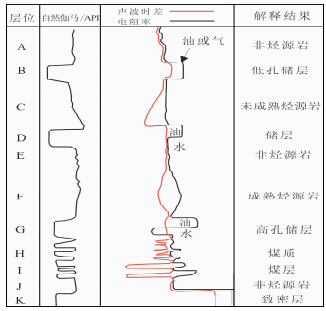 |
图 4 ΔlogR叠合图上各种特征示意图 (数据源于Passey et al., 1990,有改动) Fig. 4 Characteristic of different formations in the ΔlogR overlapping diagram (data from Passey et al., 1990,modified) |
ΔlogR法基本原理是将适当刻度的声波孔隙度曲线重叠到电阻率曲线上,由于孔隙度曲线响应于低密度、低声波速度的干酪根,而电阻率曲线响应于地层流体,在饱含水、贫有机质地层中由于孔隙度和电阻率都响应于孔隙度变化,两条曲线重合;在含油气储层或富有机质层非储层中两条曲线分开(王贵文等,2002; 谭茂金和张松扬,2010;郭泽清等,2012).有机碳含量的计算公式为

电阻率曲线和声波曲线对孔隙度都很敏感,孔隙度变化会影响两条曲线的响应,一条曲线幅度变化也会影响另一条曲线,而且这种变化成比例,因此如果电阻率和孔隙度曲线正确标定,孔隙度增加就可对电阻率和声波曲线引起相同幅度的偏移,以消除确定有机碳含量时对孔隙度的依赖(刘超等,2014).但是,ΔlogR模型中也存在一些不足:
(1)ΔlogR计算依赖于基线值;
(2)计算有机碳含量时对成熟度LOM存在很大依赖性,若LOM估计不准确,则计算值就会产生误差;
(3)计算公式中叠合系数选用固定值0.02.
针对以上不足,我国一些学者对ΔlogR法做了改进:
(1)胡慧婷等人推导出利用电阻率和声波时差最大值和最小值计算ΔlogR的方法,因此无需读取基线值,避免了由于基线值不同需要分段求取ΔlogR的问题(胡慧婷等,2011);
(2)曲彦胜等人建立TOC与ΔlogR的线性关系,并用利用实际数据得出拟合系数,解决了LOM对确定有机碳含量影响的问题(曲彦胜等,2011);
(3)张立强等人提出将叠合系数看作变量,需要考虑干酪根和烃类流体的比例(张立强等,2004).
3.2 核磁共振和密度测井结合由于干酪根与地层流体密度相近,干酪根在密度测井上被识别为孔隙;而核磁共振测井仅响应于地层流体,干酪根在核磁共振测井上表现为骨架,因此密度测井与核磁共振测井确定孔隙度的差值可反映干酪根体积,进而可将干酪根体积转换为有机碳含量 ,利用核磁共振测井和密度测井确定有机碳含量的岩石物理模型如图 5所示(Jacobi et al., 2008).
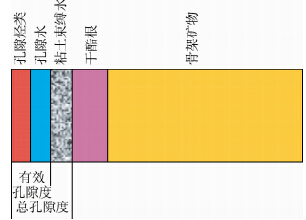 |
图 5 利用核磁共振和密度测井确定有机碳含量的岩石物理模型(据Jacobi, 2005,有改动)
Fig. 5 Petrophysical model of TOC determination with combination of NMR and density logging (data from Jacobi, 2005,modified) |
根据核磁共振测井和密度测井确定的孔隙度值可得到干酪根体积为

ρl=ρma(1-Vf-Vk)+ρfVf+ρkVk;NMR=VfHIf,
式中,Vk为干酪根体积;Vf为孔隙流体体积;ρma为骨架密度值;ρk为干酪根密度;ρf为孔隙流体密度;φNMR为核磁共振测井确定的总孔隙度;HIf为流体的含氢指数.将得到的干酪根体积转换为有机碳含量:

利用核磁共振测井和密度测井结合的方法可以较精确评价地层有机碳含量,但在粘土矿物含量较多的情况下,密度测井确定的骨架密度不准确,且利用核磁共振测井不能得到准确的地层总孔隙度真值.因此,后来的学者对该方法做了改进,Quirein等人和Murphy等人提出利用地层元素测 井资料获取骨架密度值,使有机碳含量计算精度提高(Quirein et al., 2012; Murphy et al., 2013);Hook等人利用短回波间隔测量得到粘土束缚水和沥青的T2值(Hook et al., 2011).
3.3 多测井结合优化算法地球物理测井值是地层中各种地质因素综合作用的结果,因此结合不同测井方法采用优化算法可有效利用储层的各种测井信息,较准确的计算地层有机碳含量(张晓玲等,2013;李林等,2010).
假设地层中由m种矿物组成,多矿物模型的测井响应方程为(马淑芳等,2010):
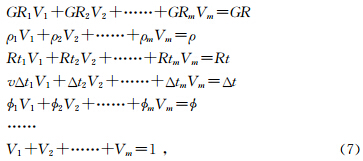
通过对上式求解得到的干酪根的体积,进而可将干酪根体积转换为有机碳含量.求解方法主要有最小二乘法(谢刚等,2007)、多元回归(Abrahao,1989)、遗传算法(冯国庆等,2002)、人工神经网络(Huang and Mark, 1996; 徐岩等,2011)等.另外,郭龙等人发现人工神经网络方法在拟合高成熟度烃源岩地层的有机碳含量时相关性不高,提出一种图版分类-模糊排队-BP神经网络联合拟合的方法(郭龙等,2009);Heidari等人确定地层界面之后首先利用单一测井方法反演地层性质,进而根据常规测井解释或XRD数据建立多组分岩石物理模型,利用迭代方法使计算和测量的地层性质差异最小而获得有机碳含量(Heidari et al., 2011);Liu等人提出采用支持向量回归(SVR)克服人工神经网络中过度学习的问题,利用由不同测井值计算得到的视测井值识别潜在的页岩储层,然后根据SVR确定的视测井值建立与有机碳含量的关系(Liu et al., 2013).
利用多测井结合优化算法可以考虑有机碳含量在不同测井曲线上的响应,提高计算结果精度和降低不确定性.但是,该方法仍需要建立测井值与有机碳含量的经验关系,也需要岩心资料进行刻度.
4 地球化学测井直接评价方法利用脉冲中子源的地层元素能谱测井仪可以同时测量非弹性散射伽马能谱和俘获伽马能谱,对非弹性散射伽马能谱解析可获取地层总碳含量(Herron et al., 2011; Radtke et al., 2012; Gonzalez et al., 2013),从总碳含量(TC)中扣除无机碳含量(TIC)可得到有机碳含量(TOC):

地层中无机碳主要存在于方解石、白云石、菱铁矿、铁白云石和菱锰矿等矿物中(Charsky and Herron, 2013),利用与无机碳相关的钙、镁、铁、锰等元素可计算出无机碳含量,图 6为加拿大西部页岩中直接确定有机碳含量的实例.
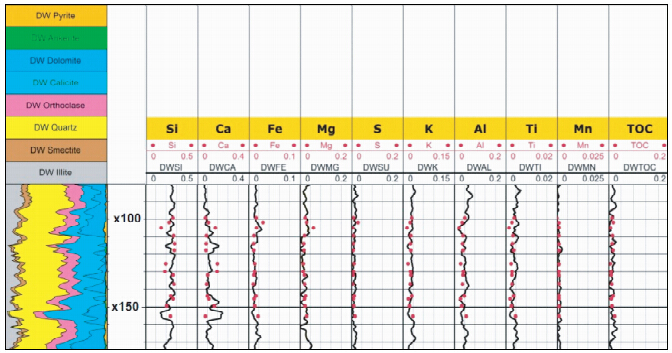 | 图 6 加拿大西部页岩中直接确定有机碳含量实例(据Radtke,2012) Fig. 6 Case study of direction determination of TOC in shale of western C and a(according to Radtke,2012) |
利用非弹性散射伽马能谱测井的地球化学测井可以直接输出地层有机碳含量,不需要岩心资料刻度,测量精度高.但是,该有机碳含量评价方法也存在一些问题和挑战:
(1)计算得到的有机碳含量不仅是干酪根中的碳含量,还包括孔隙中烃类的碳,因此要得到真正意义上的有机碳含量需要扣除烃类中的碳含量,这很具有挑战性.
(2)在非常规的页岩储层中,由于矿物组成复杂,地层中的钙、镁、铁、锰等元素不仅仅存在于碳酸盐矿物中,还存在于一些粘土矿物中,无机碳含量计算比较复杂.
5 总结与讨论5.1 利用测井资料可得到经济、快速、直观、较为准确的有机碳含量连续测量结果,根据有机碳含量测井评价技术的进展,将其分为三个主要发展阶段:单一测井间接评价方法、不同测井结合间接评价方法和地球化学测井直接评价方法.利用单一测井评价方法的影响因素较多,其精度要低于多测井结合的方法;但相比利用地球化学测井直接评价方法,利用单一测井评价和多测井结合的方法都是间接评价方法,其计算结果不确定性要大.
5.2 目前常用的有机碳含量测井评价方法主要是利用自然伽马能谱测井、ΔlogR法及多测井结合优化方法,利用自然伽马能谱测井的方法是一种简便有效的手段,但受其他含铀矿物的影响;ΔlogR法是一种经典的有机碳含量评价方法,利用电阻率和孔隙度曲线对有机质的响应特征提供相对准确的有机碳含量结果,但是计算公式依赖于基线值、热成熟度指数及叠合系数等参数;多测井结合优化方法可有效利用各种测井信息,减小不同环境因素的影响,但仍是根据岩心分析数据建立测井值与有机碳含量关系的间接评价方法.另外,利用间接评价方法时,需要有足够多的岩心分析资料作刻度,以尽量减小有机碳含量确定误差.
5.3 地球化学测井直接评价方法是利用先进的脉冲中子地球化学测井技术实现,可直接输出有机碳含量结果,测量精度进一步提高;但是,计算得到的有机碳含量包括孔隙中烃类流体的碳,需要得到真正意义上的有机碳含量还需结合其他测井方法扣除烃类中的碳含量.
| [1] | Abrahao D. 1989. Well-log Evaluation of Lacuctrine Source Rocks of the Lagoa Feia Formation, Lower Cretaceous, Campos Basin, Offshore Brazil. SPWLA 30th Annual Logging Symposium, Paper I. |
| [2] | Beers R F. 1945. Radioactivity and organic content of some Paleozoic Shales[J]. AAPG Bulletin, 29(1): 1-22. |
| [3] | Charsky A, Herron S. 2013. Accurate, Direct Total Organic Carbon (TOC) Log from a New Advanced Geochemical Spectroscopy Tool: Comparison with Conventional Approaches for TOC Estimation[C]. AAPG Annual Convention and Exhibition, paper 41162. |
| [4] | Chen Z H, Zha M, Jin Q. 2004. Application of natural gamma ray logging and natural gamma spectrometry logging to recovering paleoenvironment of sedimentary basin[J]. Chinese Journal of Geophysics (in Chinese), 47(6): 1145-1150. |
| [5] | Feng G Q, Zhang J, Zhang L H, et al. 2002. Realizing genetic algorithm of optimal log interpretation[J]. Natural Gas Industry (in Chinese), 22(6): 48-51. |
| [6] | Fertl W H, Chilingar G V. 1988. Total organic carbon content determined from well logs[J]. SPE Formation Evaluation, 3(2): 407-419. |
| [7] | Flower J G. 1983. Use of Sonic-Shear-Wave/Resistivity overlay as a Quick-Look method for identifying potential pay zones in the Ohio (Denvonian) shale[J]. Journal of Petroleum Technology, 35(3): 638-642. |
| [8] | Gonfalini M. 1991. Evaluation of the organic carbon content from geophysical well log interpretation in carbonate Triassic source rocks of the Streppenosa Basin, Sicily (Italy)[C]. 13th World Petroleum Congress, Paper 24113. |
| [9] | Gonzalez J, Lewis R, Hemingway J, et al. 2013. Determination of formation organic carbon content using a new neutron-induced gamma ray spectroscopy service that directly measures carbon[C]. SPWLA 54th Annual Logging Symposium, Paper GG. |
| [10] | Guo L, Chen J F, Miao Z Y. 2009. Study and application of a new overlay method of the TOC content[J]. Natural Gas Geoscience (in Chinese), 20(6): 951-956. |
| [11] | Guo Z Q, Sun P, Liu W H. 2012. The carbon calculation by ΔlogR technology in Sanhu Area of Qaidam Basin[J]. Progress in Geophysics (in Chinese), 27(2): 626-633. |
| [12] | Heidari Z, Torres C, Preeg W E. 2011. Quantitative method for estimating total organic carbon and porosity, and for diagnosing mineral constituents from well logs in shale-gas formations[C]. SPWLA 52nd Annual Logging Symposium, Paper Q. |
| [13] | Herron M M, Grau J A, Herron S L, et al. 2011. Total organic carbon and formation evaluation with wireline logs in the green river oil shale[C]. SPE Annual Technical Conference and Exhibition, SPE 147184. |
| [14] | Herron S L. 1987. A total organic carbon log for source rock evaluation[J]. The Log Analyst, 28(6): 50-58. |
| [15] | Hook P, Fairhust D, Ryalander E, et al. 2011. Improved Precision Magnetic Resonance Acquisition: Application to Shale Evaluation[C]. SPE Annual Technical Conference and Exhibition, SPE 146883. |
| [16] | Hu H T, Lu S F, Liu C, et al. 2011. Models for calculating organic carbon content from logging information: Comparison and analysis[J]. Acta Sedimentologica Sinica (in Chinese), 29(6): 1199-1205. |
| [17] | Huang Z H, Williamson M A. 1996. Artificial neural network modelling as an aid to source rock characterization[J]. Marine and Petroleum Geology, 13(2): 277-290. |
| [18] | Huo Q L, Zeng H S, Fu L, et al. 2011. The advance of ΔlgR method and its application in Songliao Basin[J]. Journal of Jilin University (Earth Science Edition) (in Chinese), 41(2): 586-591. |
| [19] | Jacobi D, Gladkikh M, LeCompte B, et al. 2008. Integrated Petrophysical evaluation of shale gas reservoirs[C]. CIPC/SPE Gas Technology Symposium 2008 Joint Conference, SPE 114925. |
| [20] | Jiang Z X, Zhang W Z, Liang C, et al. 2014. Characteristics and evaluation elements of shale oil reservoir[J]. Acta Petrolei Sinica (in Chinese), 35(1): 184-196. |
| [21] | Li L, Liu B, Li X S, et al. 2010. Application of Multi-Attribute prediction to the Weixinan depression dominate source rock[J]. Process in Geophysics (in Chinese), 25(5): 1737-1743. |
| [22] | Li Y J, Zhang L H, Feng Y Y, et al. 2013. Logging evaluation method and its application for measuring the total organic carbon content in shale gas[J]. Natural Gas Geoscience (in Chinese), 24(1): 169-175. |
| [23] | Liu C, Lu S F, Xue H T. 2014. Variable-coefficient ΔlogR model and its application in shale organic evaluation. Process in Geophysics (in Chinese), 29(1): 312-317. |
| [24] | Liu Y X, Chen Z H, Hu K Z, et al. 2013. Quantifying Total Organic Carbon (TOC) from well logs using support vector regression[C]. GeoConvention 2013: Integration. |
| [25] | Lu Q H, Zhang J Y, Li S X. 2006a. Application of log data to oil source rock evaluation[J]. Well Logging Technology (in Chinese), 30(1): 80-83. |
| [26] | Lu Q H, Zhang J Y, Li S X. 2006b. Evaluation of oil source rock on logging data-A case study in well Wang 46. Progress in Exploration Geophysics (in Chinese), 29(2): 140-144. |
| [27] | Ma S F, Han D K, Gan L D, et al. 2010. A review of seismic rock physics models[J]. Progress in Geophysics (in Chinese), 25(2): 460-471. |
| [28] | Mendelzon J D, Toksoz M N. 1985. Source rock characterization using multivariate analysis of log data[C]. SPWLA 26th Annual Logging Symposium, Paper UU. |
| [29] | Meyer B L, Nederlof M H. 1984. Identification of source rock on wireline logs by Density/Resistivity and sonic transit time/resistivity Crossplots[J]. AAPG Bulletin, 68(2): 121-129. |
| [30] | Murphy E, Warner M, Sarmah B B. 2013. A workflow to evaluate porosity, mineralogy, and TOC in the Utica-Point pleasant shale play[C]. SPE Eastern Regional Meeting, SPE 165682. |
| [31] | Nixon R P. 1973. Oil source beds in cretaceous mowry shale of north western interior United States[J]. AAPG Bulletin, 57: 57-65. |
| [32] | Pang J F. 2005. Physical Basis of Nuclear Logging[M] (in Chinese). Beijing: Petroleum Industry Press. |
| [33] | Passey Q R, Creaney S, Kulla J B, et al. 1990. A practical model for organic richness from porosity and resistivity logs[J]. AAPG Bulletin, 74(12): 1777-1794. |
| [34] | Pemper R, Han X G, Mendez F, et al. 2009. The direct measurement of carbon in wells containing oil and natural gas using a pulsed neutron mineralogy tool[C]. SPE Annual Technical Conference and Exhibition, SPE 124234. |
| [35] | Qu Y S, Zhong N N, Liu Y, et al. 2011. Using logging methods to calculate organic matter abundance of source rocks and its influencing factors[J]. Northwest Oil and Gas Exploration (in Chinese), 23(2): 80-84, 99. |
| [36] | Quirein J, Murphy E, Praznik G, et al. 2012. A comparison of core and well log data to evaluate porosity, TOC, and hydrocarbon volume in the eagle ford shale[C]. SPE Annual Technical Conference and Exhibition, SPE 159904. |
| [37] | Radtke R J, Lorente M, Adolph B, et al. 2012. A new capture and inelastic spectroscopy tool takes geochemical logging to the next level[C]. SPWLA 53rd Annual Logging Symposium, Paper AAA. |
| [38] | Rao S, Zhu C Q, Wang Q, et al. 2013. Thermal evolution patterns of the Sinian-Lower paleozoic source rocks in the Sichuan Basin, Southwest China[J]. Chinese Journal of Geophysics (in Chinese), 56(5): 1549-1559. |
| [39] | Rieke H H, Oliver D W, Fertl W H, et al. 1983. Successful application of carbon/oxygen logging to coalbed exploration[J]. Journal of Petroleum Technology, 35(2): 421-428. |
| [40] | Schmoker J W. 1980. Organic content of devonian shale in western applalachian basin[J]. AAPG Bulletin, 64(11): 2156-2165. |
| [41] | Schmoker J W. 1981. Determination of Organic-matter content of appalachian devonian shales from gamma-ray logs[J]. AAPG Bulletin, 65(7): 1285-1298. |
| [42] | Schmoker J W, Hester T C. 1983. Organic carbon in Bakken formation, united states portion of Williston basin[J]. AAPG Bulletin, 67(12): 2165-2174. |
| [43] | Shi S H. 1995. Well logging evaluation technology of oil source rocks in Jiangling depression[J]. Jianghan Petroleum Science and Technology(in Chinese), 5(3): 48-52. |
| [44] | Swanson V E. 1960. Oil Yield and Uranium Content of Black Shales[C]. Geological Survey Professional Paper 356-A, US Atomic Energy Commission. |
| [45] | Swanson V E. 1961. Geology and Geochemistry of Uranium in Marine Black Shales, A Review[C]. Geological Survey Professional Paper 356-C, US Atomic Energy Commission. |
| [46] | Tan M J, Zhang S Y. 2010. Progress in geophysical logging technology for shale gas reservoirs[J]. Progress in Geophysics (in Chinese), 25(6): 2024-2030. |
| [47] | Tan T D. 1988. Recognition of oil source rocks with well logging[J]. Well Logging Technology (in Chinese), 12(6): 1-11. |
| [48] | Teng J W, Liu Y S. 2013. Analysis of distribution, storage potential and prospect for shale oil and gas in China[J]. Progress in Geophysics (in Chinese), 28(3): 1083-1108. |
| [49] | Tissot B P, Welte D H. 1978. Petroleum Formation and Occurrence: A New Approach to Oil and Gas Exploration[M]. New York: Springer-Verlag. |
| [50] | Wang G W, Zhu Z Y, Zhu G Y. 2002. Logging identification and evaluation of Cambrian-Ordovician source rocks in Syneclise of Tarim Basin[J]. Petroleum Exploration and Development (in Chinese), 29(4): 50-52. |
| [51] | Wu J F, Yang S C, Zhang G C, et al. 2013. Geothermal history and thermal evolution of the source rocks in the Deep-water Area of the Northern South China Sea[J]. Chinese Journal of Geophysics (in Chinese), 56(1): 170-180. |
| [52] | Witkowsky J M, Galford J E, Quirein J A, et al. 2012. Predicting pyrite and total organic carbon from well logs for enhancing shale reservoir interpretation[C]. SPE Eastern Regional Meeting, SPE 161097. |
| [53] | Xie G, Hu Z P, Luo L, et al. 2007. Logging identification of complicated lithology with constrained least square algorithm[J]. Well Logging Technology (in Chinese), 31(4): 354-356. |
| [54] | Xu Y, Shu P, Ji X Y. 2011. A research on object-control geology modeling of volcano reservoir with seismic and logging data in Xushen gas field. Chinese Journal of Geophysics (in Chinese), 54(2): 336-342. |
| [55] | Xin Y P, Qiu N S, Li H L. 2011. The range of secondary hydrocarbon generation of lower palaeozoic source rock in Tarim Basin[J]. Chinese Journal of Geophysics (in Chinese), 54(7): 1863-1873. |
| [56] | Yan J P, Cai J G, Zhao M H. 2009. Advances in the study of source rock evaluation by geophysical logging and its significance in resource assessment[J]. Progress in Geophysics (in Chinese), 24(1): 270-279. |
| [57] | Zhao Y C. 1990. The theory and application of logging for source rock evaluation-from the working results evaluation in Nanyang and Biyang depressions[J]. Earth Science (in Chinese), 15(1): 65-74. |
| [58] | Zhao Y C, Ma Z, Yao G Q. 1994. A potential measurement to evaluation source rock[J]. Well Logging Technology (in Chinese), 18(4): 240-247. |
| [59] | Zhang J Y. 2014. Well logging evaluation method of shale oil reservoirs and its application[J]. Progress in Geophysics (in Chinese), 27(3): 1154-1162. |
| [60] | Zhang L Q, Luo X R, He D F, et al. 2004. Sequence boundaries of the lower cretaceous, Southern Jungar Basin[J]. Acta Sedimentologica Sinica (in Chinese), 22(4): 606-613. |
| [61] | Zhang X L, Xiao L Z, Xie R H, et al. 2013. Petrophysical workflow for shale gas evaluation[J]. Progress in Geophysics (in Chinese), 28(4): 1962-1974. |
| [62] | Zhu G Y, Jin Q, Zhang L Y. 2003. Using log information to analyse the geochemical characteristics of source rocks in Jiyang depression[J]. Well Logging Technology (in Chinese), 27(2): 104-109. |
| [63] | 陈中红, 查明, 金强. 2004. 自然伽玛及自然伽玛能谱测井在沉积盆地古环境反演中的应用[J]. 地球物理学报, 47(6): 1145-1150. |
| [64] | 冯国庆, 陈军, 张烈辉,等. 2002. 最优化测井解释的遗传算法实现[J]. 天然气工业, 22(6): 48-51. |
| [65] | 郭龙, 陈践发, 苗忠英. 2009. 一种新的TOC含量拟合方法研究与应用[J]. 天然气地球科学, 20(6): 951-956. |
| [66] | 郭泽清, 孙平, 刘卫红. 2012. 利用Δlog技术计算柴达木盆地三湖地区第四系有机碳[J]. 地球物理学进展, 27(2): 626-633. |
| [67] | 胡慧婷, 卢双舫, 刘超, 等. 2011. 测井资料计算源岩有机碳含量模型对比及分析[J]. 沉积学报, 29(6): 1199-1205. |
| [68] | 霍秋立, 曾华森, 付丽,等. 2011. Δlog测井源岩评价方法的改进及其在松辽盆地的应用[J]. 吉林大学学报(地球科学版), 41(2): 586-591. |
| [69] | 姜在兴, 张文昭, 梁超,等. 2014. 页岩油储层基本特征及评价要素[J]. 石油学报, 35(1): 184-196. |
| [70] | 李林, 刘兵, 李绪深,等. 2010. 多属性预测在涠西南凹陷烃源岩研究中的应用[J]. 地球物理学进展, 25(5): 1737-1743. |
| [71] | 李延钧, 张烈辉, 冯媛媛,等. 2013. 页岩有机碳含量测井评价方法及其应用. 天然气地球科学, 24(1): 169-175. |
| [72] | 刘超, 卢双舫, 薛海涛. 2014. 变系数Δlog方法及其在泥页岩有机质评价中的应用[J]. 地球物理学进展, 29(1): 312-317. |
| [73] | 陆巧焕, 张晋言, 李绍霞. 2006a. 测井资料在生油岩评价中的应用[J]. 测井技术, 30(1): 80-83. |
| [74] | 陆巧焕, 张晋言, 李绍霞. 2006b. 利用测井资料进行生油岩评价—以王46井生油岩评价为例[J]. 勘探地球物理进展, 29(2): 140-144. |
| [75] | 马淑芳, 韩大匡, 甘利灯,等. 2010. 地震岩石物理模型综述[J]. 地球物理学进展, 25(2): 460-471. |
| [76] | 庞巨丰. 2005. 核测井物理基础[M]. 北京: 石油工业出版社. |
| [77] | 曲彦胜, 钟宁宁, 刘岩,等. 2011. 烃源岩有机质丰度的测井计算方法及影响因素探讨[J]. 岩性油气藏, 23(2): 80-84, 99. |
| [78] | 饶松, 朱传庆, 王强,等. 2013. 四川盆地震旦系-下古生界烃源岩热演化模式及主控因素[J]. 地球物理学报, 56(5): 1549-1559. |
| [79] | 施生华. 1995. 江陵凹陷生油岩测井评价技术[J]. 江汉石油科技, 5(3): 48-52. |
| [80] | 谭茂金, 张松扬. 2010. 页岩气储层地球物理测井研究进展[J]. 地球物理学进展, 25(6): 2024-2030. |
| [81] | 谭廷栋. 1988. 测井识别生油岩方法[J]. 测井技术, 12(6): 1-11. |
| [82] | 腾吉文, 刘有山. 2013. 中国油气页岩分布与存储潜能和前景分析[J]. 地球物理学进展, 28(3): 1083-1108. |
| [83] | 王贵文, 朱振宇, 朱广宇. 2002. 烃源岩测井识别与评价方法研究[J]. 石油勘探开发, 2002, 29(4): 50-52. |
| [84] | 吴景富, 杨树春, 张功成,等. 2013. 南海北部深水区盆地热历史及烃源岩热演化研究[J]. 地球物理学报, 56(1): 170-180. |
| [85] | 谢刚, 胡振平, 罗利,等. 2007. 基于约束最小二乘理论的复杂岩性测井识别方法[J]. 测井技术, 31(4): 354-356. |
| [86] | 徐岩, 舒萍, 纪学雁. 2011. 松辽盆地徐深气田火山岩气藏地质约束-测井地震建模方法探讨[J]. 地球物理学报, 54(2): 336-342. |
| [87] | 辛艳朋, 邱楠生, 李慧莉. 2011. 塔里木盆地下古生界烃源岩二次生烃范围研究[J]. 地球物理学报, 54(7): 1863-1873. |
| [88] | 闫建平, 蔡进功, 赵铭海,等. 2009. 运用测井信息研究烃源岩进展及其资源评价意义[J]. 地球物理学进展, 24(1): 270-279. |
| [89] | 赵彦超. 1990. 生油岩测井评价的理论和实践——以南阳、泌阳凹陷为例[J]. 地球科学, 15(1): 65-74. |
| [90] | 赵彦超, 马正, 姚光庆. 1994. 碳氧比测井——一种潜在的生油岩评价工具[J]. 测井技术, 18(4): 240-247. |
| [91] | 张晋言. 2012. 页岩油测井评价方法及其应用[J]. 地球物理学进展, 27(3): 1154-1162. |
| [92] | 张立强, 罗晓容, 何登发,等. 2004. 准噶尔盆地南缘下白垩统层序界面的识别[J]. 沉积学报, 22(4): 606-613. |
| [93] | 张晓玲, 肖立志, 谢然红,等. 2013. 页岩气藏评价中的岩石物理方法[J]. 地球物理学进展, 28(4): 1962-1974. |
| [94] | 朱光有, 金强, 张林晔. 2003. 用测井信息获取烃源岩的地球化学参数研究[J]. 测井技术, 27(2): 104-109. |
 2014, Vol. 29
2014, Vol. 29

